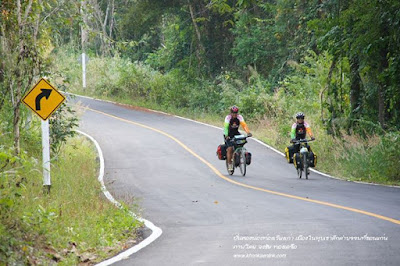This national park always reminds tourists about dinosaurs. Indeed, nobody had formerly ever though the Isan plateau was once home of dinosaurs. Until 1976 when a uranium survey team discovered a piece of fossil, which was examined by French specialists and declared that it was a left knee bone of a dinosaur. After that, serious execration has never ended until now.On the hill Pratu Ti Ma, which was the first site, geologists have found fossils of a dinosaur, 15 metres high with a long neck and tail. This is a kind of plant-eating dinosaur never found else where before, so it was named Phuwiangosaurus Sirindhornae to honour H.R.H Princess Maha Chakri Sirindhorn. In this site, over ten teeth of a meat-eating dinosaur have also been found. So geologists and scientists presumed that the long-necked dinosaur was prey for these teeths owner. Among these teeths, one is different. After a study, scientist found that it belonged to a new species of dinosaur never found before. So it was named Siamosaurus Suteethorni after the discoverer, Mr. Warawuth Suteethorn.
All the three sites are not far from the headquarters, and tourists can also visit the second and third sites nearby.Fossils of Siamotyrannus Isanensis found here are the oldest ones, dating back 120-130 million years. This indicates that tyrannosaurus originated in Asia. These fossils are now displayed in the museum of the Department of Mineral Resources.At the 8th site, there are 68 footprints of dinosaurs, dating back 140 million years ago. Most of them belong to the world's smallest species of meat-eating dinosaur, which walked on two legs. Among such footprints, there is one bigger footprint, assumed to belong to Carnosaurus.These sites are 19 kilometres from the headquarters. It takes an hour to get there by car and four-wheel drive vehicle is recommended. In many sites, geologists found fossils of dinosaur babies, small crocodiles and mussels dating back to 150 million years ago.
Besides fossils of dinosaurs, there are also traces of ancient civilizations in this area including a high relief of the reclining Buddha on the cliff, at the crest of Phu Wiang Mountain. The Buddha image was carved in the 9th century, mirroring an influence from Indian art. Nearby is Tham Famue Daeng, Dang, or Red Palm Cave, at Ban Hin Rong. The cave wall houses prehistoric paintings of cavemen's hands from sprays of red ochre.
Natural attractions in the park include waterfalls and field of wild flowers. Namtok Thap phaya Suea is a small waterfall near to Tham Famue Daeang. Namtok Tat Fa is a 15-metre high waterfall that can be accessed by car. The waterfall is 18 kilometres from Amphoe Phu Wiang. Some 5 kilometres from Namtok Tat Fa is Namtok Tat Klang which is a 8-metre high waterfall. Savanna and rock plateaus are always blanketed with wild flowers in full bloom by the end of the rainy season.Phu Wiang National Park acquires a total area of 380 square kilometres in Amphoe Si Chomphu and Amphoe Chum Phae.How to get there: from downtown Khon Kaen, visitors can get there via Highway 12 and connect to Highway 2038, bound for Amphoe Phu Wiang. From Amphoe Phu Wiang, talk the Phu Wiang-Ban Muaeng Mai Road, passing the national park unit, Pak Chong Phu Wiang at kilometre 23. Turn left at kilometre 30 at Ban Pho Reservoir and the national parks headquarters is 8 kilometres away. The headquarters features an exhibition about the dinosaurs and fossils found in the area. For group tourists requiring a guide, contact the headquarters in advance at Tel. 0 4324 9052.





















